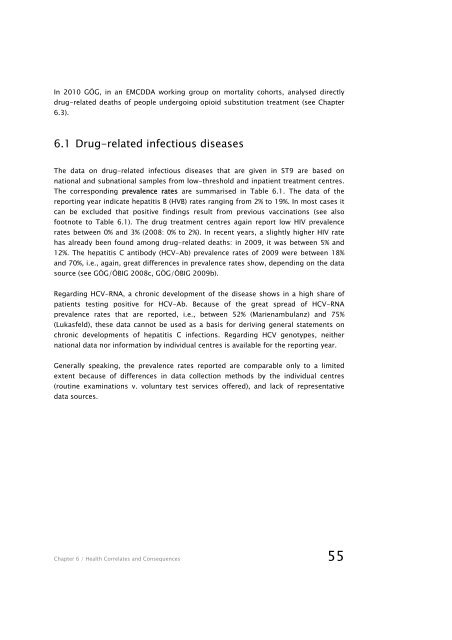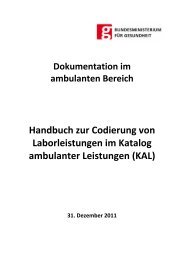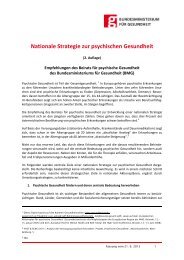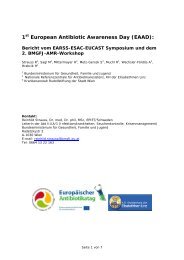Report on the Drug Situation 2010 - Bundesministerium für ...
Report on the Drug Situation 2010 - Bundesministerium für ...
Report on the Drug Situation 2010 - Bundesministerium für ...
- No tags were found...
You also want an ePaper? Increase the reach of your titles
YUMPU automatically turns print PDFs into web optimized ePapers that Google loves.
In <strong>2010</strong> GÖG, in an EMCDDA working group <strong>on</strong> mortality cohorts, analysed directlydrug-related deaths of people undergoing opioid substituti<strong>on</strong> treatment (see Chapter6.3).6.1 <strong>Drug</strong>-related infectious diseasesThe data <strong>on</strong> drug-related infectious diseases that are given in ST9 are based <strong>on</strong>nati<strong>on</strong>al and subnati<strong>on</strong>al samples from low-threshold and inpatient treatment centres.The corresp<strong>on</strong>ding prevalence rates are summarised in Table 6.1. The data of <strong>the</strong>reporting year indicate hepatitis B (HVB) rates ranging from 2% to 19%. In most cases itcan be excluded that positive findings result from previous vaccinati<strong>on</strong>s (see alsofootnote to Table 6.1). The drug treatment centres again report low HIV prevalencerates between 0% and 3% (2008: 0% to 2%). In recent years, a slightly higher HIV ratehas already been found am<strong>on</strong>g drug-related deaths: in 2009, it was between 5% and12%. The hepatitis C antibody (HCV-Ab) prevalence rates of 2009 were between 18%and 70%, i.e., again, great differences in prevalence rates show, depending <strong>on</strong> <strong>the</strong> datasource (see GÖG/ÖBIG 2008c, GÖG/ÖBIG 2009b).Regarding HCV-RNA, a chr<strong>on</strong>ic development of <strong>the</strong> disease shows in a high share ofpatients testing positive for HCV-Ab. Because of <strong>the</strong> great spread of HCV-RNAprevalence rates that are reported, i.e., between 52% (Marienambulanz) and 75%(Lukasfeld), <strong>the</strong>se data cannot be used as a basis for deriving general statements <strong>on</strong>chr<strong>on</strong>ic developments of hepatitis C infecti<strong>on</strong>s. Regarding HCV genotypes, nei<strong>the</strong>rnati<strong>on</strong>al data nor informati<strong>on</strong> by individual centres is available for <strong>the</strong> reporting year.Generally speaking, <strong>the</strong> prevalence rates reported are comparable <strong>on</strong>ly to a limitedextent because of differences in data collecti<strong>on</strong> methods by <strong>the</strong> individual centres(routine examinati<strong>on</strong>s v. voluntary test services offered), and lack of representativedata sources.Chapter 6 / Health Correlates and C<strong>on</strong>sequences 55
















